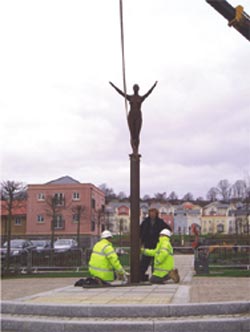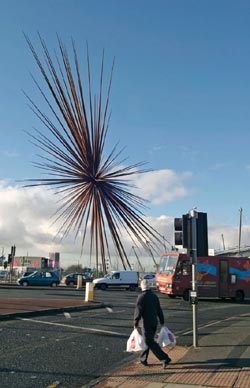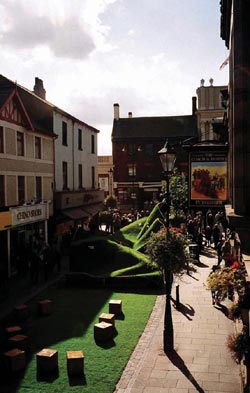PASW Regional Newsletter: Autumn 2005
Regional Network Meeting Report
'You can't put that there!'- health and safety issues in public art commissioning.
Taunton, 12 April 2005
Maggie Bolt welcomed everyone to the meeting saying that she was delighted to see such an interesting mix of people for what many considered to be a very dry subject, but one that could often make or break a scheme or project. Maggie went on to say that she had come across a CABE publication which was produced for the Urban Summit on Sustainable Communities, 'What are we scared of? The value of risk in designing public space'. This raised some important points about the general climate with regard to risk.
Maggie then read out a couple of statements from the publication to set the scene for the day:
'The simultaneous rise of the risk and creativity agendas is one of the great paradoxes today, given that risk-avoidance strategies often cancel out inventiveness. (Yet) we increasingly demand that citizens, business and public institutions be creative, explore and experiment to survive and be competitive in a globalised worldÖ' taken from Charles Landry's essay.
The second quote was from the landscape architect, Kathyrn Gustafson, who was talking about the Diana Memorial Fountain. Maggie commented, "I am often intrigued and delighted by how artists and designers view public space in relation to how people use it. The assumptions made by this designer are very interesting in relation to how observation of the usage of a site or place should be approached."
'I feel we made a mistake in letting people walk in the water. I apologise for that. I thought people would picnic near the memorial, and run their hands through the water, think about their lives, think about Diana'.
Maggie concluded by asking, "Was this naïve or an acceptable starting point?" and stated that she was sure that the presentations and plenary for the afternoon would give everyone an opportunity to discuss this further. She then handed over to Andrew Kelly, Chair for the day.
Andrew Kelly welcomed everyone to the meeting, before introducing Paul Talbot from Crest Nicholson. Paul started by saying that Crest Nicholson's core business is around brown field regeneration and urban renewal. He gave examples of schemes that they were currently working on in the South West: Gloucester Docks, Bristol Harbourside, Port Marine near Bristol, Bath and Portishead. Crest Nicholson had been involved in commissioning public art within these schemes and recognized that it was an essential ingredient in 'place making' and, as such, an important part of its work. The company also recognized the important role that public art plays in terms of working with communities and projecting a positive image for the company. Paul went on to show a number of slides illustrating the diversity of work that the company has commissioned, including stand alone sculptural pieces, artists in residence schemes, work with schools and competitions.
"Health and safety issues", he said, "have to be taken very seriously especially in relation to the school projects." He talked about how it is essential to have a process of recording, alongside procedures such as risk assessments and safety audits.

Installations of The Angels of Portishead by Rick Kirby
Photo: Stuart Clamp
Paul acknowledged that safety issues were very different today and, as contractors and developers, Crest Nicholson, treated the issue with great importance. Paul quoted some national statistics about health and safety in the UK for 2003/4 ñ 235 fatal injuries, 159,809 reported injuries, 2.2 million cases of ill health caused by or made worse by work, and 39 million working days lost due to work related ill health or workplace injury. "This", he said, "illustrated how essential it was that health and safety issues were enshrined in our work culture".
Paul went on to talk about the practical application of health and safety issues and about Construction Design Management (CDM Regulations) that came into being in 1994, the aim of which was to eliminate, reduce and inform. "Artists", Paul said, "should be contributing to the overall health and safety plan for projects and should, as a matter of course, be pro-actively risk aware and charged with a duty of care to eliminate and/or reduce risks". "This, however", he said, "should not be about stifling creativity".
The meeting was then shown a slide of a risk assessment ñ this identified an activity, the potential risks, who was affected, an analysis of the risks and then a strategy for their control. "Being risk aware from the very start of the project", Paul said, "was fundamental". He then touched on the issue of the on-going maintenance of work and the importance of defining where the responsibility for this lies.
Paul ran through a series of slides that illustrated potential risks ñ for example the height of work, the logistics of installing work and water and the perception of safety. He concluded his presentation with the following quote: "Safety is applied common sense and accidents happen when common sense is absent".
Andrew thanked Paul for his presentation and invited questions from the audience. The questions and comments covered issues of:
- the foresight that is required in relation to the use of work and how objects can take on different uses, for example, the Diana Memorial Fountain in London, where this seemed to have been ignored
- perceptions of what is safe and the issue of whether we should be putting some risk back into children's play
- how much risk you need to take out of work and the fact that it should not be about designing risk out completely, but about being aware of it
- indemnity insurance and how difficult it was for artists to obtain this, often because of cost and difficulty in easily identifying risks.
Andrew then went on to introduce Nader Mokhtari of Manage Limited. Nader started with his conclusion: how, despite not being a risk taker, he viewed the culture of 'you can't put that there!' as a huge block on creativity. "It must", he said, "be about working together and recognizing that health and safety is an integral part of good design. The starting point", he stated, "must be a good team of people who are capable of thinking out of their boxes and work that is integral, not bolted on at the end of a scheme".
Nader talked about three very complex projects that he had worked on with Thomas Heatherwick. The first was the 'Blue Carpet' in Newcastle. He managed the project on behalf of the client, co-ordinating the engineering. The challenge of this project was to do something new with the area in question, having defined the space, how it was used and how people felt about it. He talked about the focus being around the surface of the space and the problems that first arose when an alternative material (i.e. recycled blue glass) was proposed, and the time that was spent persuading people that it could be done. "In the end", Nader said, "problems were solved and minds were changed. The important lesson was that it is exciting to undertake design, but what is essential is a focused team, which has a common desire to achieve an innovative design and solve problems".
With the 'B of the Bang' outside the new Manchester Stadium, Nader acted as project manager for the artist rather than the client. The commission was won through a competition, and the first task was to convince the panel that the project was achievable! Using images, Nader talked through the process of the design and how it was fabricated and installed. He finished by saying that he felt the success of the project was due to the team being fully committed, from designers through to fabricators and the fact that the client trusted them to get on and deliver it, without too much interference.

B of the Bang by Thomas Heatherwick Studio
Photo: Len Grant
The third project that Nader talked about was 'Bleigiessen', commissioned for the atrium space of a new building for the Welcome Trust in London. One unusual constraint issued by the commissioner was that the work had to fit through the front door and that it could not affect the building process in any way. Thomas Heatherwick then decided to go one step further and create a work which could be delivered through the letterbox! The construction of the work, made from dichromatic glass beads, weighed 14 tons in total and involved 100,000 meters of wire which, logistics aside, raised a number of health and safety issues. One of the major issues that Nader cited was the fact that the other contractors on the site were not under their control and this added another dimension to their health and safety issues. Nader concluded his presentation by showing images of this extraordinary work, which took four months of 24-hour shifts to build and which was completed in December 2004.
Andrew thanked Nader for his presentation and invited the audience to ask questions. The issues raised comprised:
- the budgets available for the projects.
- the different experiences of managing a project on behalf of the client and then on behalf of the artist.
After a short break for tea, the meeting reconvened and Andrew introduced designer, Walter Jack. Walter started his presentation by saying that he had no professional qualification for health and safety and he would therefore re-title his talk, 'Not sure that you can put that there. I need to talk to ÖÖ..' As a designer, Walter said he had skills that were invaluable to him in order to realise work. When architects work with contractors it is a well-trodden path, but when artists work with contractors the path is not so well trodden.
Walter said that he was interested in innovative craft. Often the processes for making the built environment tended to be mass processes but when unusual processes were involved you came up against unusual risks, often not thought of before.
Walter showed images of a number of projects he worked on and talked about the health and safety issues related to each work. The first was a reception point for a local authority swimming pool where issues of risk had come up at the very beginning of the commissioning process, because of the materials involved.
The second project was St Peter's Square in the creative quarter in Leeds. For this project, which was run by an agency, the whole square had been designed as one space. They had taken responsibility for making everything and this, Walter felt, offered them the flexibility needed for fabrication. He went on to talk about the anti-slip devices in the wooden floor and how problems had arisen when the contractor, whom they had been subcontracted to, decided to leave out the anti-slip element of the design.
Walter went on to talk about 'The Green', a temporary project carried out in towns in Yorkshire, which was part of the ëPeople Making Places' initiative. With this project, the safety issues had to be assessed by each of the town centre managers, resulting in a plethora of views. The problem often was that the safety officers saw the work for the first time on site and therefore it was very difficult to assess the risks prior to this.

The Green by Walter Jack
Photo: Grenville Charles
With the road bridge project in Essex, Walter said that as soon as he met the team he recognized real creativity and this, together with a very creative engineer, had made a significant difference to the project. If a client is really enthusiastic to do something and is prepared to put the effort and thought in, then, Walter said, you get fantastic work.
The next project that Walter talked about, a staircase for Barton Hill in Bristol, had been fraught with problems. These problems arose because they were contracted to the client and not to the main contractor. With the staircase not having been included in the whole design, they were left to create the work around another ambitious work, the building, which resulted in them often feeling like they were working by stealth.
The last two examples he gave, a Home Zone in Bristol and a proposal for Slough Town Centre, raised the issue that if a proposal is made to do something which hasn't been done before, there has to be a desire on the part of the client to make it happen. "A brief", he said, "should not preclude anything on safety grounds because otherwise it precludes innovation". In conclusion, Walter said that support for artists was essential if good work was to be created; better work for better clients.
After thanking Walter, Andrew moved the meeting into the plenary session and invited questions and comments. A lively discussion took place which touched on many issues, including:
- how you go about assessing and determining risk
- the need for good design; work that is fit for purpose
- the need to determine responsibilities at an early stage of a project
- the importance of trust between an artist and client
- the need for long term maintenance policies
- how often constraints on a project can result in even more creative solutions
- the ever increasing litigious nature of society
- the fact that planning authorities do not absolve a client of his responsibilities
- the importance of anticipating risk
- the issue that liability lies with everyone involved in a project
- the fact that the Health & Safety Executive are currently targeting designers because of the belief that a lot of risks can be dealt with at the design stage
- the need for artists and other professionals working on projects to get information about where to go for advice on health and safety issues
- the inherent creative tension in all the issues being talked about.
The meeting was concluded by Maggie Bolt, who thanked the speakers and delegates for taking part. She indicated that PASW planned to work on putting formal advice about health and safety issues on the website in the future.
